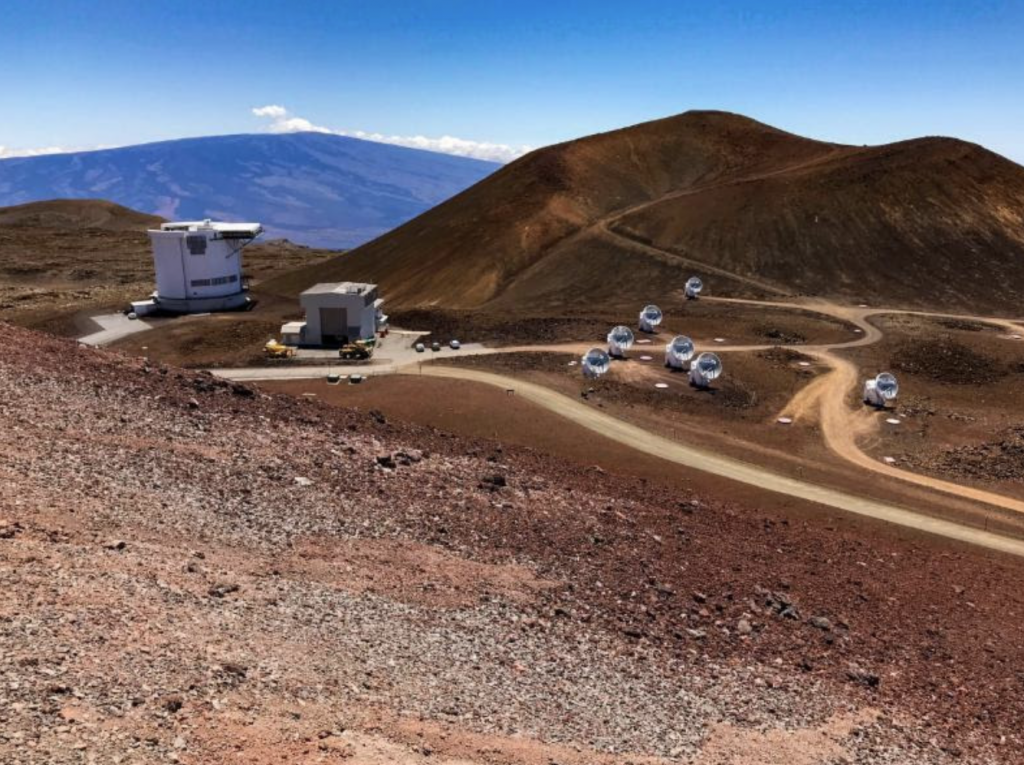UH Hilo Professor Names Black Hole Capturing World’s Attention
Two of the world’s most powerful telescopes, located atop Maunakea on Hawaiʻi Island, played a vital role in producing the world’s very first image of a black hole that now bears a Hawaiian name.
Hawaiʻi-based James Clerk Maxwell Telescope (JCMT) and Submillimeter Array (SMA) are part of the unprecedented Event Horizon Telescope project. JCMT is operated by the East Asian Observatory, SMA is operated by the Smithsonian Astrophysical Observatory and the Academia Sinica Institute of Astronomy and Astrophysics.
Astronomers collaborated with renowned UH at Hilo Ka Haka ʻUla O Keʻelikōlani Hawaiian language professor and cultural practitioner Larry Kimura for the Hawaiian naming of the black hole. Pōwehi, meaning embellished dark source of unending creation, is a name sourced from the Kumulipo, the primordial chant describing the creation of the Hawaiian universe. Pō, profound dark source of unending creation, is a concept emphasized and repeated in the Kumulipo, while wehi, or wehiwehi, honored with embellishments, is one of many descriptions of pō in the chant.
“It is awesome that we, as Hawaiians today, are able to connect to an identity from long ago, as chanted in the 2,102 lines of the Kumulipo, and bring forward this precious inheritance for our lives today,” said Kimura. “To have the privilege of giving a Hawaiian name to the very first scientific confirmation of a black hole is very meaningful to me and my Hawaiian lineage that comes from pō, and I hope we are able to continue naming future black holes from Hawaiʻi astronomy according to the Kumulipo.”
In April 2017, a groundbreaking observational campaign brought together eight telescopes at six locations around the globe to capture an image of Pōwehi, a supermassive black hole at the center of the Messier 87 galaxy. The announcement was made to the world on Wednesday, April 10, 2019.

The James Clerk Maxwell Telescope (left) and Submillimeter Array (right) atop Maunakea play a critical role in the success of the Event Horizon Telescope. PC: Maunakea Observatories
“Maunakea makes this discovery and the spectacular image of Pōwehi possible,” said Jessica Dempsey, deputy director of JCMT. “Its perfect remote position, and the dry conditions on Maunakea’s summit, allow JCMT and SMA to collect the tiny amount of light that only touches our planet in a few very special places. Like the mountain itself, every drop of light we gather is precious.”
The SMA and JCMT telescopes are key members of the Event Horizon Telescope project, which links together strategically placed radio telescopes across the globe to form a larger, Earth-sized telescope powerful enough to see a lehua flower petal on the moon.
John O’Meara, chief scientist at W. M. Keck Observatory stated the following:
“On behalf of W. M. Keck Observatory, I’d like to congratulate the Event Horizon Telescope (EHT)
Collaboration, which includes members of our Maunakea Observatories ‘ohana—the James Clerk
Maxwell Telescope (JCMT) and the Submillimeter Array (SMA), on successfully capturing the first-ever image of a black hole.
We are thrilled by this morning’s announcement unveiling EHT’s first results—a direct image
confirmation of the shadow of the supermassive black hole at the center of Messier 87. This truly is a
fundamental leap towards significantly advancing our understanding of black holes, one of the most
enigmatic objects in the universe, and providing new tests of general relativity, the theory underlying them.
Supermassive black holes, like the other one EHT studied at the center of our Milky Way galaxy, are of
significant interest; understanding their behavior and environment is one of the signature areas of research that Keck observers, like Andrea Ghez of UCLA’s Galactic Center Group, have been leading for over 20 years.
We enthusiastically look forward to the important science and new discoveries that will undoubtedly
come as a result of EHT’s exciting breakthrough, and give our heartfelt congratulations to all the teams involved.”

















